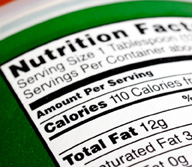Attention Grocery Shoppers: Counting Calories Made Simpler
 Reading nutritional labels can feel like you are reading a foreign language sometimes. But the good news is that new simplified nutritional labels are on the way and will be placed on the front of the package. The United States Department of Agriculture and the United States Department of Health and Human Services have released new dietary guidelines to help consumers make better-informed decisions on the calories that they consume.
Reading nutritional labels can feel like you are reading a foreign language sometimes. But the good news is that new simplified nutritional labels are on the way and will be placed on the front of the package. The United States Department of Agriculture and the United States Department of Health and Human Services have released new dietary guidelines to help consumers make better-informed decisions on the calories that they consume.
As part of the American Beverage Association’s (ABA) Clear on Calories initiative, beverage makers like The Coca-Cola Company are putting calorie information at the fingertips of consumers. Beverage companies have pledged that all beverage containers 20 ounces and smaller will display total calorie counts on the front of their can or bottle. Also company-controlled vending machines and soda fountains will display calorie counts on selection buttons or in close proximity to the machines.
“It’s exciting to see beverage companies move the labels to the front and make them easier to understand for consumers,” said registered dietitian Daniel Santibanez. “We all need to make informed decisions about the products we are consuming, and making nutrition labels easier to find and understand is just one step forward in that direction.”
During your next shopping trip, use these five tips to improve your label literacy:
1. Take note of serving sizes and calorie count. Your favorite sandwich cookie may be only 160 calories per serving, but are you really going to stop after one serving?
2. Look at the total calories and the calories coming from fat. According to the U.S. Food and Drug Administration, 40 calories per serving is low, while 100 calories is moderate and 400 calories is high.
3. Plan your meals before you go shopping. Try to prepare meals that are not only tasty but also low in calories. Doing so will help you avoid buying items that are not on your shopping list while also shielding you from high-calorie snacks.
4. Carry a calorie “cheat sheet.” Sometimes you will come across foods in the grocery that do not have nutrition labeling. Carry a calorie sheet, or use a mobile phone app.
5. Read the Percent Daily Value (DV). The DV is formulated for a 2,000 calorie diet, but it can provide a basic guideline even if you consume more or less.
The next time you’re at the grocery store or fountain machine, start reading the nutrition labels or calorie counts, and you’ll find yourself making more informed, healthier choices.
Comments are closed.